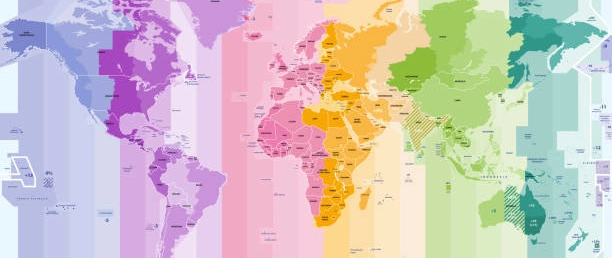The Journey Begins: Understanding Time Beyond Ticks and Tocks
Imagine you're scheduling a video call with colleagues across the globe. What seems like a simple task quickly becomes a puzzle of temporal complexity (due to multiple timezones involved). Welcome to the wild world of timezones – where time is not just a number, but a intricate tapestry of geographical, political, and scientific considerations.
What Exactly is a Timezone?
At its core, a timezone is a region of the Earth that observes a uniform standard time. But don't be fooled by this seemingly simple definition. Timezones are anything but straightforward.
Before the invention of precise timekeeping, each location determined noon as when the sun was directly overhead. As communication and transportation evolved, this hyper-local approach became impractical. Enter standardized timezones – a human attempt to bring order to the chaotic world of time.
The Geographic Dance: Latitude, Longitude, and Time
Latitude and longitude are the geographical coordinates that help us understand where we are on Earth's surface:
- Latitude: Measures distance north or south of the equator (0 to ±90 degrees)
- Longitude: Measures distance east or west of the Prime Meridian (0 to ±180 degrees)
These coordinates are crucial in determining timezone. Theoretically, every 15 degrees of longitude represents a one-hour difference in time. However, political boundaries and practical considerations often make this a rough guideline rather than a strict rule.
The Curious Case of Daylight Saving Time
Daylight Saving Time (DST) is humanity's attempt to "hack" time. Introduced to conserve energy during World War I, it involves moving clocks forward in spring and backward in autumn.
Why? The original rationale was to make better use of daylight hours. Farmers could work longer, and energy could be saved by reducing artificial lighting needs. However, its effectiveness is now hotly debated.
Interesting fact: Not all countries observe DST, and those that do change their clocks on different dates!
UTC: The Time Referee
Coordinated Universal Time (UTC) is the world's time standard. Think of it as the global referee that keeps everyone's watch synchronized. UTC replaced Greenwich Mean Time (GMT) and provides a consistent, scientifically precise time reference.
Standardized Timezones: A Global Framework
-
Standard Timezone Types:
- Geographical Timezones: Based on longitude and physical location
- Political Timezones: Defined by national or regional boundaries
- UTC-based Timezones: Offset from Coordinated Universal Time (UTC)
-
Standardized Timezone Examples:
- UTC±0: Greenwich Mean Time (London, UK)
- UTC-5: Eastern Standard Time (New York, USA)
- UTC+5:30: India Standard Time (Entire Indian subcontinent)
- UTC+9: Japan Standard Time (Tokyo, entire Japan)
- UTC+2: Eastern European Time (Cairo, Egypt)
-
Timezone Offset Patterns:
- Full Hour Offsets: UTC+1, UTC-3, UTC+8
- Fractional Hour Offsets:
- UTC+5:30 (India)
- UTC+5:45 (Nepal - unique case!)
- UTC+3:30 (Iran)
-
Standardization Mechanisms:
- IANA Timezone Database: Authoritative global timezone repository
- ISO 8601: International standard for time representation
- RFC 5322: Internet standard for timezone formatting
Striking Political Timezone Examples:
-
China
- Geographically spans five natural time zones
- Politically uses a single timezone: UTC+8
- Beijing time applies uniformly across 3,000 miles
-
Russia
- Spans 10 time zones geographically
- Politically reduced to 9 administrative timezones
- Political decisions override natural geographical time divisions
-
India
- Uses a single timezone (UTC+5:30)
- Chosen to represent a middle ground across its vast longitude range
- Political decision to promote national unity
-
Australia
- Uses multiple timezones that varies state by state
Time Representation: A Multifaceted Approach
-
Unix Timestamp
- Seconds elapsed since January 1, 1970
- Pros: Universal, easy to calculate, language-agnostic
- Cons: Less human-readable, limited by 32-bit integer range
-
ISO 8601 Format
- Example:
2023-11-15T14:30:00Z - Pros: Standardized, includes timezone information
- Cons: More complex, slightly verbose
- Example:
-
RFC 3339
- Similar to ISO 8601, used extensively in internet protocols
- Example:
2023-11-15T14:30:00+00:00
Timezone Challenges in Software Development
Developers face a Gordian knot of timezone complexities:
Political Boundaries Change
Countries can and do modify their timezone rules, sometimes with little notice.Daylight Saving Time Variations
Different regions have different DST rules and transition dates.Historical Time Inconsistencies
Before standardization, local times were incredibly varied.
Best Practices for Timezone Handling
Database Storage
CREATE TABLE events (
id UUID PRIMARY KEY,
event_time TIMESTAMP WITH TIME ZONE, -- Store in UTC
original_timezone VARCHAR(50) -- Store IANA timezone identifier
);
Frontend Representation
// Convert UTC to local time
function formatLocalTime(utcTimestamp, timezone) {
return new Date(utcTimestamp)
.toLocaleString('en-US', { timeZone: timezone });
}
Recommended Libraries and Tools
-
Python:
pytz,dateutil -
JavaScript:
moment-timezone,date-fns -
Java:
java.timepackage - Database: PostgreSQL's robust timezone support
The IANA Timezone Database
The Internet Assigned Numbers Authority (IANA) maintains the most comprehensive timezone database. It's continuously updated to reflect global timezone changes.
Sample IANA Timezone Identifiers:
America/New_YorkEurope/LondonAsia/Tokyo
Pro Tips for Timezone Mastery
- Always store times in UTC
- Convert to local time only for display
- Use IANA timezone identifiers
- Regularly update timezone databases
- Handle edge cases like leap seconds and historical time changes
Closing Thoughts: Embracing the Timezone Complexity
Timezones are a testament to human complexity. They remind us that even something as seemingly objective as time is subjective, political, and ever-changing.
For developers, understanding timezones is not just about code – it's about respecting the global diversity of human experience.
Mental Exercise
Try scheduling a meeting across five different continents. Feel the timezone pain firsthand!
Author's Note: Time is relative, but timezone bugs are absolute pain. ⏰🌍



Top comments (0)